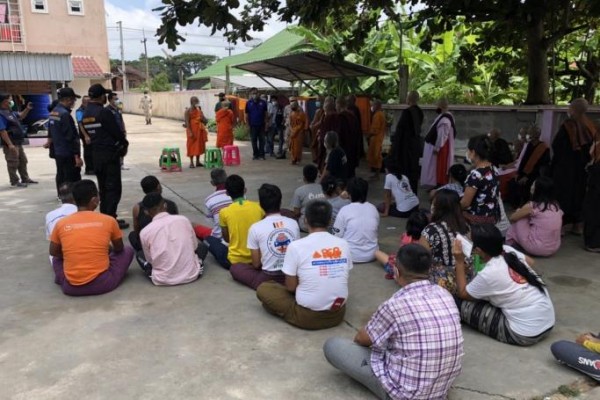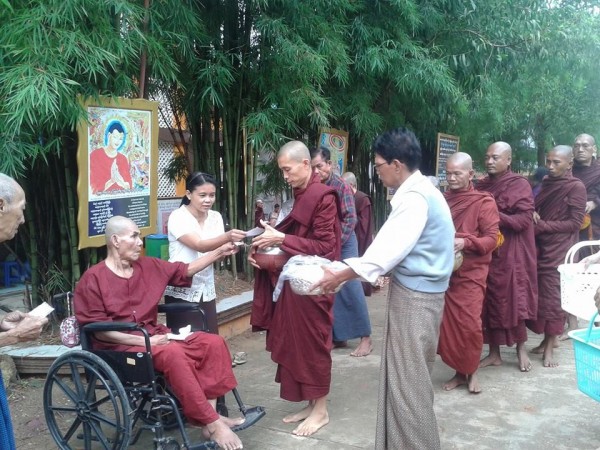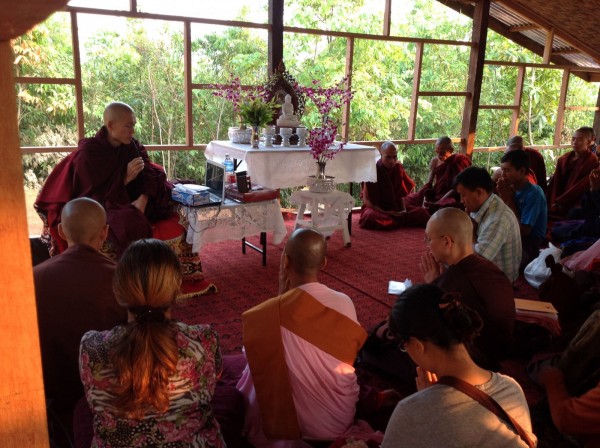In a country torn by ethnic and political conflict, the altruistic deeds of Buddhist monks can fall under the radar of political activists, and the soldiers pursuing their deadly military campaign. What threats and choices do the devout face in Myanmar, and can Buddhism assist from across the border in Thailand? Robert Bociaga reports.
The noise of falling bombs, military jets, shelling and burning fill the heads of many Myanmar refugees attempting to find peace in neighboring Thailand.
In one of the monasteries located in the border town of Mae Sot, around 80 people were recently apprehended by the Thai police for not having valid travel documents. Some were forced to leave their houses behind, and have lost everything.
Now, they are desperate to go anywhere.
“It is very dangerous to send them back to the hands of Myanmar military now they are banned from entry to Thailand,” says Khema Cari, the nun of the Thabarwa Monastery.
She has tried to negotiate the best way to handle the refugee's difficult situation, as Thailand is not a signatory to the 1951 Refugee Convention and has no laws in place to provide refugees with any legal status.
“Some officers were helping, others not,” she added, pointing at the historically complex relationship between Myanmar and Thailand – once two competing kingdoms, and still countries which very often do not see things eye-to-eye over issues like border control.

Refugees from Myanmar arrested in Mae Sot/ photo Thabarwa Centre
The Thai media has reported on the subject, suggesting that the Thai officers had in fact apprehended Myanmar spies that had been tracking the pro-democracy activists. Some Myanmar media also repeated that claim, labelling the monastery as supportive of the coup leaders.
“Sayadaw (the term for the senior monk) is not from either side of the conflict,” says Khema Cari. “He has spent his life feeding and protecting people, and how could he be against them? He is against no one.”
“So many people are trying to escape Myanmar, even mothers with children. Some villagers are burnt, so in the Thabarwa Refuge Centre in Mae Sot they can take rest and see how to proceed, without feeling lost.”
In the Thai monastery, “they would eventually abandon their anger and stay at peace and safety,” she explains.
A SMALL BUDDHIST EMPIRE
The headquarters for the monastery is located in the port town of Thanlyin, south of Myanmar's largest city, Yangon.
It provides shelter, food, and other aid to mostly landless people who come to meditate.
The surroundings might not look like the haven of calm and serenity that one typically associates with Buddhist temples, but nevertheless the Thabarwa Monastery attracts hundreds of people seeking solace through meditation, and people looking to perform merits.
But in the tense borderlands between Myanmar and Thailand the situation is much more volatile. People have been experiencing unimaginable cruelties, and finding refuge just outside of the country would give them a necessary respite,
Yet this ended abruptly when the Thai officers arrived, threatening to deport them.
While the Thabarwa Monastery conducts social aid and relief work in dozens of its sub-centres, in accordance with the Buddhist teachings, many people in Myanmar allege that the monastery is not on the right side of history.
But in post-coup Myanmar, how can ordinary people openly criticise the generals for their actions, without risking imprisonment, or worse ? The Myanmar military continues to suppress protest movements across the country, with civilian deaths still commonplace. The army has reportedly burned down more than 28,000 civilian homes since they took control in February 2021, and civilian deaths currently total more than 2,300.

Sayadaw and Buddhist monks collect donations / photo R Thabarwa Centre
For monastery student Bhante Varrapanyo, “Sayadaw is being practical, as he has a lot of people under his protection and everything he’s doing is from the position of wisdom and serenity”.
“Sayadaw can’t conduct a rebellion in the forest with pistols,” he says, "yet he still finds a way to spread dhamma, do the social work and the human rights work”.
Others accuse Sayadaw of suggesting that democracy could threaten Buddhism. Ki Ki, one of his adherents, recalls him saying that in the developed Myanmar, people would forget Buddhism and follow materialism.
Nevertheless, she remains a loyal practitioner, and hopes to see the end of the problems in the country thanks to the help of her master.
PEACEMAKING EFFORTS ON THE HORIZON?
The accusations claiming the monastery supports the military junta show just how deeply divided Myanmar society is, with both sides demanding their opponents be utterly condemned.
In such a climate of on-going violence, there is no space for compromise. Both sides of the conflict claim to have monopoly on truth and power, and the junta has ignored any opportunity over the last year to compromise or de-escalate the situation, remaining in armed conflict with its own people.
The military junta, that took power on February 1, 2021, has outlawed criticism, killed and jailed opponents and forced others to join the resistance movement. The Burman-dominated military also remains in conflict with armed ethnic groups in the regions. Some of these conflicts have run for decades.
On the other hand, the pro-democracy National Unity Government group descends from the elected representatives of the parliament, and has called for all Myanmar people to abandon their jobs with the junta administration, and join the efforts in bringing the generals down.
Many of the soldiers of the NUG's armed wing, the People’s Defence Force have assassinated senior civil servants working for the junta, as well as others they regard as collaborators.
The UNHCR estimates that the number of internally displaced people has now exceeded one million, while many others have become deeply impoverished, facing food insecurity due to rising prices, disrupted transportation links, and crops destroyed due to flooding.
The international community has to date been unsuccessful in brokering any form of peace between the warring parties, both of whom reject the idea of mediation.
ASEAN (Association of Southeast Asian Nations) has forwarded a supposed peace plan, however the generals running Myanmar have little to no interest in it, preferring to remain a pariah state in the region.
ASEAN has threatened to take further action against Myanmar, but that will prove difficult due to the limitations of ASEAN itself, and the lack of support from other authoritarian member states in Southeast Asia.
Recently, the Myanmar military executed a group of its political opponents, dispelling any hope there may be a peaceful way forward in the short term.
UN agencies seeking to provide humanitarian assistance to the people displaced by the conflict are also in a difficult position. In order to operate, they needed to present their credentials to the generals, which has stirred objections from many in Myanmar, who perceive this as a form of endorsement of the military junta.

Buddhist teaching at the Tharbawa Meditation Centre/ photo Thabarwa Centre
FIGHTING AN ENEMY WITHIN OURSELVES
In the Buddhist teachings, anger is identified as an unskillful affliction. Anger is hot, reactive, and potentially decimating. However feeling anger, but not holding onto it, can clarify and energize one’s commitment to social change.
“Sayadaw fights anger with peace and that’s the most powerful weapon,” says Khema Cari. “The anger of both military the side and pro-democracy side is natural, and Sayadaw can handle it with nature,” pointing out that ‘Thabarwa’ means ‘nature’ in Burmese.
“People will eventually abandon their anger and stay at peace – that’s our philosophy,” she explains.
For the people of Myanmar, that philosophy is a recurring wish a year and a half after the junta seized control.
Meanwhile, the junta announced earlier this year it intended to build the world's largest sitting Buddha sculpture.
But it will take a great deal more than a Buddha statue to solve the current violent standoff crippling Myanmar.
+ Banner Image : The south-east corner of the 70m moat surrounding Mandalay Palace/ image G Acton +
- Asia Media Centre